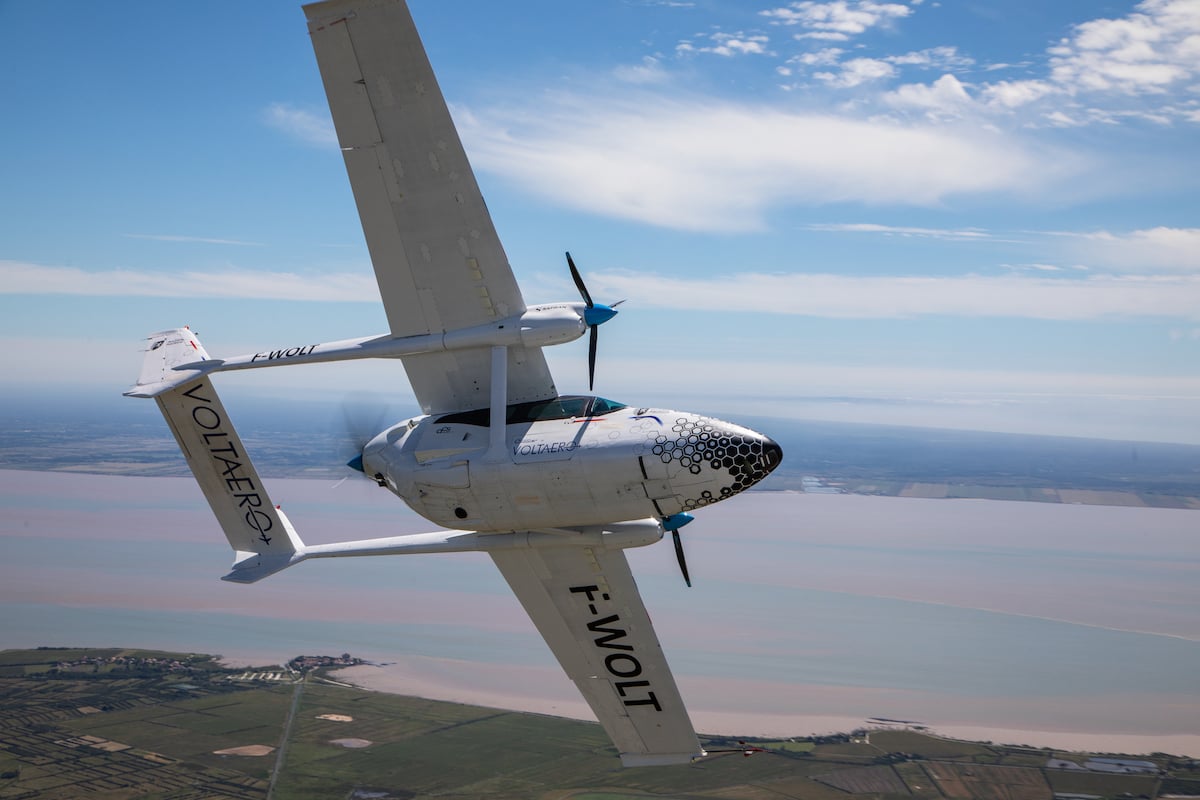VoltAero has had to postpone plans for a week of demonstration flights with its Cassio hybrid-electric aircraft in the Netherlands. That's because Dutch aviation regulators refused to accept the experimental approval that had already been agreed upon by their counterparts in France, where the start-up is based. In a July 11 statement confirming the postponement of plans announced in May, the company called on European airworthiness authorities to more closely coordinate and standardize their approach to regulating new electric aircraft.
The Cassio 1 technology demonstrator aircraft had been expected to be part of Dutch efforts to introduce electric-powered commercial passenger flights within five years under its Power Up initiative. In the flight trials, program engineers had planned to assess operational costs, noise performance, ground infrastructure requirements, and technical support for the future use of Cassio family aircraft by commercial aviation operators.
The Power Up initiative involves the four main regional airports in the Netherlands (Eindhoven Airport, Rotterdam The Hague Airport, Groningen Airport Eelde, and Maastricht Aachen Airport) with the support of the Schiphol Group and other partners aimed at facilitating and stimulating the introduction of electric Regional Air Mobility (eRAM) in the Netherlands. A so-called open-source accelerator, the initiative brings together aircraft manufacturers (OEMs), airlines, and airports in a joint effort to improve regional connectivity.
The suspension of Cassio’s involvement in the flight trials happened during final preparations when VoltAero says a “mismatch” between the French and Dutch regulations became apparent. Dutch regulations stipulate that only aircraft registered in the Netherlands can conduct flight testing in its airspace and using its airports. According to the company, in France experimental aircraft like the Cassio 1 are not generally registered as “normal” aircraft.
In an effort to resolve the administrative disconnect, France’s DGAC agency issued a statement to clarify Cassio’s legal standing but this was not sufficient for the Dutch regulator. VoltAero complained that this unforeseen problem has revealed inconsistencies in how development work on new aircraft is regulated by different European states, even those that are members of EASA.
According to VoltAero CEO Jean Botti, the difficulties could undermine efforts to certify new sustainable aviation technology. “It is heartbreaking to see that the joint efforts of VoltAero and Power Up have been blocked by these inconsistencies,” said the former Airbus executive. “This is not only a problem for our specific demonstration flights, which would have involved just five days of flying; it could hinder the electric aviation industry’s evolution as a whole. There is a need for testing new technologies across countries and borders. We call on policymakers throughout Europe to work towards harmonized regulations to ensure that the development of new sustainable aircraft technology can be achieved as efficiently as possible.”
VoltAero’s proprietary electric-hybrid powertrain has undergone extensive airborne evaluations since 2020 on the Cassio 1 testbed in its 600-kilowatt full-power output. Cassio 1 has flown more than 10,000 kilometers (5,400 nm) in operations in France and the UK as VoltAero readies the propulsion system and battery chain for airworthiness certification.
Cassio aircraft will use their propulsion system’s electric motors for all-electric power during taxi, takeoff, primary flight, and landing. The hybrid feature—using an internal combustion engine—serves as a range extender, recharging the batteries while in flight. The hybrid element also serves as a backup in the event of a problem with the electric propulsion.
VoltAero plans three production versions of the Cassio aircraft, ranging in capacity from four to 12 seats. It is marketing the family for operation with airlines, air taxi/charter companies, and private owners, as well as for utility-category service for cargo, postal delivery, and medical evacuation (Medevac) applications.
The company plans first to gain certification for the Cassio 330, which carries four or five seats and is powered by a 330-kilowatt electric-hybrid power module. The company’s six-seat Cassio 480 will feature 480 kilowatts of electric-hybrid propulsion power, while the 10- to 12-seat Cassio 600 will fly on 600 kilowatts.
The Cassio design features a forward canard and an aft-set wing with twin booms that support a high horizontal tail. The company plans to gain certification to Europe’s EASA CS23 specification in the single-engine, general aviation category.
VoltAero intends to build the Cassio aircraft at a dedicated facility at Rochefort Airport in France’s Nouvelle-Aquitaine region. It expects to break ground on the plant this year.
The concerns raised by VoltAero this week about apparent inconsistencies in rules governing test flights of experimental aircraft surfaced within days of the UK’s Air Accident Investigation Branch publishing a report into an April 2021 crash involving a Piper M Series used by ZeroAvia to evaluate its hydrogen propulsion system. The report recommended several changes to the oversight of flight tests.
